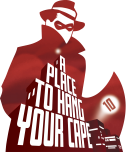Junction Jones and his trusted cat sidekick Nibs are a pair of private investigator enigmas. The idea that these two individuals are the stars of a noir-crime comic is absurd. I feel like they might be better off as a buddy-cop combo. But the reality of it is, they’re darker than meets the eye. They’re a violent combo that lurks through alleyways and hides in the shadows of the surface, galivanting across the underworld looking for materials to sell in the black market. Writer TC Pescatore creates a very interesting world, with government secrets and worlds colliding. As a matter of fact, Junction Jones gets his name from the multidimensional town of Junction. This is the story of Junction Jones and the Corduroy Conspiracy.
The color palette is the defining feature of this graphic novel. It sets the tone and pulls on different genres and media pieces that create the atmosphere of Junction Jones and the Corduroy Conspiracy. The scheme is very neon-noir, something that reminds me a lot of Wolverine’s outing in Logan. It’s that divide between the initial-colored release of Logan against its black-and-white version. As for what this means for Junction Jones and the Corduroy Conspiracy; the high-contrast and monochromatic panels and pages are very reminiscent of noir and detective novels. Very Raymond Chandler and The Big Sleep, as well as Alan Moore’s From Hell. The pastel neon colors of the cover, on the other hand, modernize the story and allude to its space and scientific hook.
Locogonzales’s design of Junction Jones is very interesting. He’s not at all what one expects for a protagonist of a detective story to look like. Not your typical brooding detective; he’s rougher around the edges, gruffer, and very Viking-like in stature and features. His cartoony look seems out of place in the serious tone of the black-and-white backdrop. But it’s this hardened and heavy look that in turn gives him an edge. Because he’s not just a detective—he’s a dangerous man. It’s actually befitting, the way he tells jokes to catch his enemies off-guard. Then—just when they’re comfortable, he strikes and spills blood. The way he quickly switches between laughing it off with the best of them, and then killing the rest of them, is unnerving.
One of the other things I really appreciate about Junction Jones and the Corduroy Conspiracy is the lack of red on the blood. I’m honestly glad we don’t see color here. Firstly, that would probably be too graphic and gruesome for many – myself included. Second of all, something about blood represented by the darkest shade of black is even more terrifying. The way it drips off the panels, and splatters across the pages is something to behold. This feeling of unease is amplified by the constant references to characteristics of real-life serial killers – such as violence toward animals. Junction Jones’ joke about the two sisters in particular is very effective in achieving this same feeling of unease. It’s like those stories you hear as a child of how to tell if you’re a psychopath. You know the one about killing the sister and meeting a guy at the funeral?
I appreciate the newspaper excerpts at the end, with real-life articles on murder cases. It just adds further to the aesthetic of the piece. Overall, Junction Jones and the Corduroy Conspiracies is foreboding but intriguing. I can’t wait to dive further into this rabbit hole!
Looking to read a mystery novel with a different and more sinister twist? A fan of Raymond Chandler or Alan Moore? Junction Jones and the Corduroy Conspiracy #1 is probably the comic for you! Get your copy over on Scout Comics and please share with us your thoughts about it on Twitter and Instagram!

